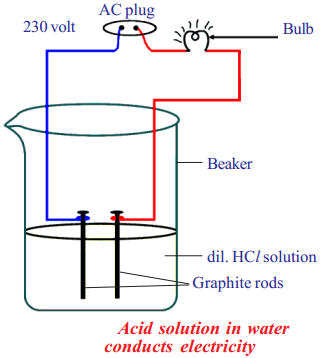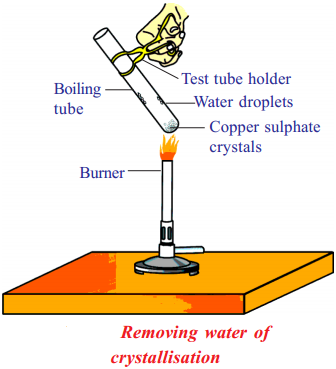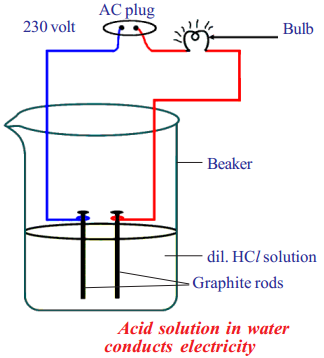Review of Your Previous Knowledge
Question 1.
Which property do you think of while suggesting the remedy from a problem of acidity?
Answer:
Neutralization Property. Antacid tablets neutralise acidity.
Improve your learning
Question 1.
Five solutions A, B, C, D and E when tested with universal indicator showed pH as 4, 1, 11,7 and 9 respectively, which solution is : (AS1)
a) neutral
b) strongly alkaline
c) strongly acidic
d) weakly acidic
e) weakly alkaline
Arrange the pH in increasing order of hydrogen ion concentration.
Answer:
Solution - pH Value
A → 4
B → 1
C → 11
D → 7
E → 9
a) Solution ‘D’ is neutral
b) Solution ‘C’ is strongly alkaline
c) Solution ‘B’ is strongly acidic
d) Solution ‘A’ is weakly acidic
e) Solution ‘E1 is weakly alkaline
∴ Increasing order of Hydrogen ion concentration : C < E < D < A < B.
Question 2.
What is a neutralization reaction? Give two examples. (AS1)
Answer:
Neutralization reaction : When acid reacts with base, forms its salt and water. This reaction is called a neutralization reaction.
Examples :

Equation: HCl + NaOH → NaCl + H2O
ii) Acetic Acid + Sodium Hydroxide → Sodium Acetate + Water
Equation : CH3COOH + NaOH → CH3COONa + H2O
Formula : Acid + Base > Salt + Water
Question 3.
What happens when an acid or base is mixed with water? (AS1)
Answer:
When an acid or base is mixed with water it changes into dilute acid or dilute base.
(OR)
Dilute acid or dilute base will be formed when an acid or base is mixed with water. Mixing an acid or base with water results in decrease in the concentration of ions (H30+/ OH-) per unit volume. Such a process is called dilution and the acid or base is said to be diluted.
Question 4.
Why does tooth decay start when the pH of mouth is lower than 5.5? (AS1)
(OR)
Does the pH change tooth decay? Explain.
Answer:
- Tooth enamel is the hardest substance in the body.
- It doesn’t dissolve in water but corroded when the pH in the mouth is below 5.5.
- It happens due to the bacteria which produce acids by degradation of sugar and food particles remaining in the mouth.
Question 5.
Why does not distilled water conduct electricit? (AS2)
Answer:
- Distilled water does not contain impurities.
- It is also extremely weak electrolyte.
- So it does not dissociate into ions.
- It does not have charge carriers.
- Because of that it does not conduct electricity.
Question 6.
Dry hydrogen chloride gas does not turn blue litmus to red whereas hydrochloric acid does. Why? (AS1)
Answer:
1. Dry hydrogen chloride gas is not an acid. Because it does not produce H+(aq) ions. Hence it can’t turn blue litmus into red.
2. Hydrochloric acid is an aqueous solution. So it can produce H+(aq) ions. Hence it can turn blue litmus into red.
Question 7.
Why pure acetic acid does not conduct electricity? (AS1)
Answer:
The reasons for pure acetic acid does not conduct electricity are :
i) Acetic acid is a weak acid.
ii) It gives fewer H3O+ions.
Question 8.
A milkman adds a very small amount of baking soda to fresh milk. (AS2)
a) Why does he shift the pH of the fresh milk from 6 to slightly alkaline?
Answer:
1. By adding a very small amount of baking soda to fresh milk, the milkman keeps the milk unspoiled for little more time than usual time.
2. As the pH value increases the milk turns to slightly alkaline.
b) Why does this milk take a long time to set as curd?
Answer:
- Curd form from the milk by the action of Lactic acid produced by bacteria in the milk.
- If milk man add Baking soda (NaHCO3) to the milk it neutralise acid, which is produced by the bacteria.
- Excess acid is required to change the milk as curd.
- It takes long time.
Question 9.
Plaster of Paris should be stored in a moisture-proof container. Explain why? (AS2)
Answer:
Storing of Plaster of Paris :
- Plaster of Paris is a white powder.
- It easily absorbs water in air and forms hard gypsum.
- So, it should be stored in a moisture-proof container.
Question 10.
Fresh milk has a pH of 6. Explain why the pH changes as it turns into curd.
Answer:
1. Fresh milk has a pH of 6. Hence it is a weak acid.
2. To turn the milk as curd, we have to add yeast in the form of some curd. The fermentation takes place during this process and lactose changes in lactic acid and the pH decreases as milk sets as curd.
Question 11.
Compounds such as alcohols and glucose contain hydrogen but are not categorized as acids. Describe an activity to prove it. (AS3)
(OR) (Activity – 7)
Write an activity to show that the solutions of compounds like alcohol and glucose do not show acidic character even though they are having Hydrogen.
(OR)
Write an activity which proves acids are good conductors of electricity.
(OR)
The acidity of acids is attributed to the H+ ions produced by them in solution explain the above statement with an activity.
List out the material for the experiment to investigate whether all compounds containing Hydrogen are acids or not and write the experimental procedure.
Answer:
List of the material required :
- Glucose
- Alcohol
- Dil. HCl
- Dil-H2SO4
- Beaker
- Connecting wires
- 230 voltage AC supply
- Bulb
- Graphite rods.
Procedure :
- Prepare glucose, alcohol, hydrochloric acid and sulphuric acid solutions.
- Connect two different coloured electrical wires to graphite rods separately as shown in figure.
- Connect free ends of the wire to 230 volts AC plug.
- Complete the circuit as shown in the figure by connecting a bulb to one of the wires.
- Now pour some dilute HCl in the beaker and switch on the current.

Observation :
The bulb starts glowing.
Repetition:
Repeat activity with dilute sulphuric acid, glucose and alcohol solutions separately.
Observation :
- We will notice that the bulb glows only in acid solutions.
- But the bulb does not glow in glucose and alcohol solutions.
Result:
- Glowing of bulb indicates that there is flow of electric current through the solution.
- Acid solutions have ions and the movement of these ions in solution helps for flow of electric current through the solution.
Conclusion :
- The positive ion (cation) present in HCl solution is H+.
- This suggests that acids produce hydrogen ions H+ in solution, which are, responsible for their acidic properties.
- In glucose and alcohol solution the bulb did not glow indicating the absence of H+ions in these solutions.
- The acidity of acids is attributed to the H+ ions produced by them in solutions.
Question 12.
What is meant by “water of crystallization” of a substance? Describe an activity to show the water of crystallisation. (Activity - 16) (AS3)
Answer:
Water of Crystallization : Water of crystallization is the fixed number of water molecules present in one formula unit of a salt in its crystaline form.
Ex : CuSO4• 5H2O.
It means that five water molecules are present in one formula unit of copper sulphate.
Activity to show the water of crystallization :
- Take a few crystals of copper sulphate in a dry test tube and heat the test tube.
- We observe water droplets on the walls of the test tube and salt turns white.
- Add 2 - 3 drops of water on the sample of copper sulphate obtained after heating.
- We observe, the blue colour of copper sulphate crystals is restored.

Reason :
1. In the above activity copper sulphate crystals which seem to be dry contain the water of crystallization, when these crystals are heated, water present in crystals is evaporated and the salt turns white.
2. When the crystals are moistened with water, the blue colour reappears.
Removing water of crystallization
Question 13.
Equal lengths of magnesium ribbons are taken in test tubes A and B. Hydrochloric acid is added to test tube A, while acetic acid is added to test tube B. Amount and concentration of both the acids are same. In which test tube will the fizzing occur more vigorously and why? (AS4)
Answer:
1. The volatility of acetic acid (CH3COOH) is more than that of hydrochloric acid.
2. But HCl solution has more strength than acetic acid.
3. Hence magnesium ribbon in test tube A will react more vigorously than in B.
4. So fizzing occurs more vigorously in test tube ‘A’.
Question 14.
Draw a neat diagram showing acid solution in water conducts electricity. (AS5)
(OR)
Draw a neat diagram which shows acids contains H+ ions.
(OR)
Draw a neat diagram showing how does dilute HCl solution conduct electricity.
Answer:

Question 15.
How do you prepare your own indicator using beetroot ? Explain. (AS5)
Aim : To prepare own indicator.
Materials required :
- 1) Beetroots-2 or 3
- 2) Knife
- 3) Bowls
- 4) Water
- 5) Spoon
- 6) Mixy
- 7) Orange juice
Procedure:
- 1) Take the beetroots and peel them with the help of a knife. (Firstly wash them).
- 2) Chop them into pieces.
- 3) Put those pieces into a mixy jar and make a paste.
- 4) Add some water to the paste. Now filter this and collect only juice from this.
Observation and Result:
1) Now add 5 to 6 drops of this juice, (beetroot juice (indicator)) to orange juice (5 to 6 drops) and mix it.
2) We can see the colour changes. This indicates the presence of acidic nature in orange juice.
Question 16.
How does the flow of acid rain into a river make the survival of aquatic life in a river difficult? (AS7)
(OR)
What are the harmful effects of acid rain?
Answer:
- 1) Acid rains are combination of carbonic acid, sulphuric acid and nitric acid with rain water.
- 2) The pH of acid rain is less than 5.6.
- 3) Living organisms can survive only in a narrow range of pH change.
- 4) When acid rain with pH value less than 5.6, flows into rivers, it lowers the pH of river water.
- 5) Due to less pH, the river water becomes acidic and hence the aquatic life in such rivers becomes difficult.
Question 17.
What is baking powder? How does it make the cake soft and spongy? (AS7)
Answer:
1) Baking Powder:
Baking powder is a mixture of baking soda (NaHCO3) and a mild edible acid such as tartaric acid. COOH (CHOH)2COOH
2) Chemical reaction :
When baking powder is heated or mixed in water, the following reaction takes place.
NaHCO3+ H+→ CO2+ H2O + Sodium salt of acid.
3) Carbondioxide produced during the reaction causes bread or cake to rise making them soft and spongy.
Question 18.
Give two important uses of washing soda and baking soda. (AS7)
(OR)
Write the chemical formulae for washing soda and Baking soda and give their uses.
(OR)
Write any four uses of washing soda.
Answer:
Uses of washing soda (Na2CO3.10H2O) :
1) Washing soda (sodium carbonate) is used in glass, soap and paper industries.
2) It is used in the manufacture of sodium compounds such as borax.
3) Sodium carbonate can be used as a cleaning agent for domestic purposes.
4) It is used for removing permanent hardness of water.
Uses of baking soda (NaHCO3 10H2O) :
1) Baking soda (Sodium hydrogen carbonate) is used for faster cooking.
2) Baking powder (a mixture of baking soda and a mild acid) is used in preparation of cakes.
3) Sodium hydrogen carbonate is also an ingredient in antacids.
4) It is also used in soda - acid, fire extinguishers.
5) It acts as a mild antiseptic.